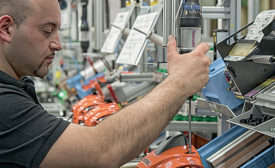Home » Keywords: » gantry robot
Items Tagged with 'gantry robot'
ARTICLES
A wide range of ready-to-install components and subassemblies enable manufacturers and integrators to quickly build custom automated assembly machines.
Read More
Robots Empower Small Manufacturers
Advances in Cartesian robot technology are enabling small and midsized manufacturers to do more with less.
April 1, 2014
Motion Control: Rigid vs. Flexible
"If production volume is high, that points to rigid automation."—Chris Knudsen, Yaskawa America Inc.
July 1, 2013
Never miss the latest news and trends driving the manufacturing industry
Stay in the know on the latest assembly trends.
JOIN TODAY!Copyright ©2025. All Rights Reserved BNP Media.
Design, CMS, Hosting & Web Development :: ePublishing








